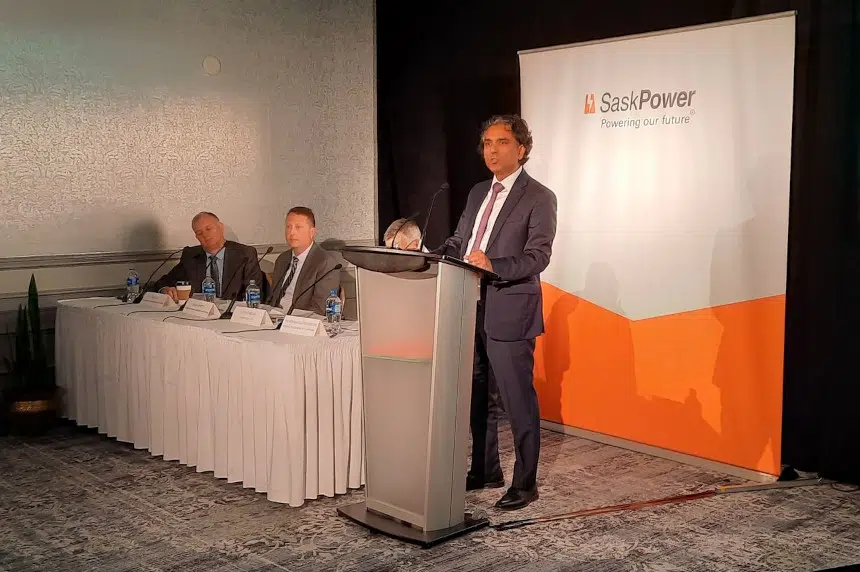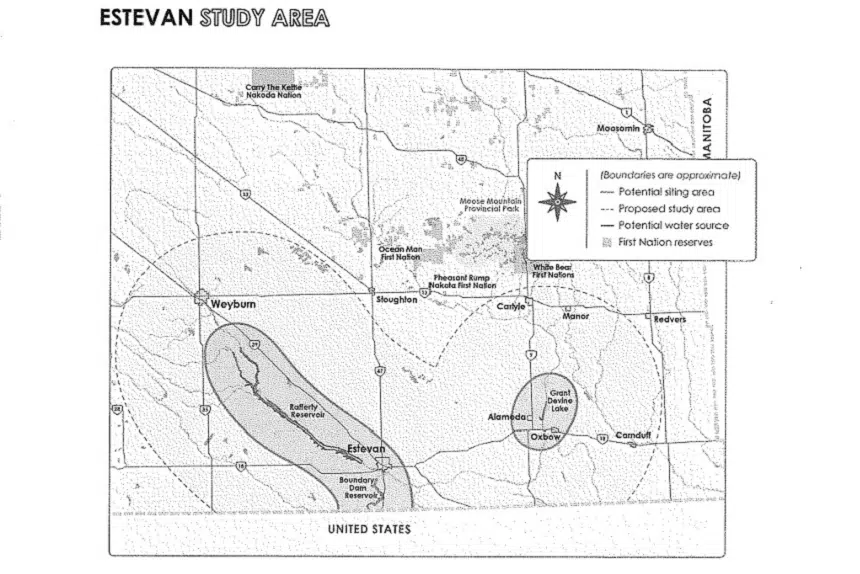SaskPower has taken another small step toward the potential of nuclear power in Saskatchewan, announcing Tuesday the two sites picked for further study to possibly be home to a small modular reactor (SMR) facility.
The Elbow area around Lake Diefenbaker, and the Estevan area near Boundary Dam, Rafferty Reservoir and Grant Devine Lake were chosen.
Rupen Pandya, the president and CEO of SaskPower, said in the search across the province, the two areas rose to the top in terms of technical suitability and regulatory risk.
“The Estevan area has been a very important part of SaskPower’s history through the Boundary Dam and Shand Power stations producing stable, reliable baseload power for decades, to the hundreds of employees that call Estevan home. And by identifying the Estevan study region, the opportunity to continue this history is exciting,” said Pandya.
He explained that Lake Diefenbaker has always been at the top of the list as a place technically suitable for a nuclear facility.
The main technical criteria in choosing the two potential sites were a proximity to a suitable body of water, proximity to existing transmission infrastructure, proximity to a population that could support a workforce, and availability of infrastructure and services like roads and emergency services.
Pandya said choosing potential sites is an important and exciting step in the process, but it’s also an early one. The final decision on nuclear power in Saskatchewan won’t be made until 2029 and, if the decision is to proceed, the first reactor wouldn’t be on line for a few more years after that.
Next, SaskPower will start looking more closely at the areas in question to find more specific spots where the facility or facilities could be located. A final site decision is expected in 2024.
The company will also start in on extensive consultations.
Pandya said SaskPower is committed to ongoing and meaningful dialogue, engagement and consultation.
“We will be in these communities, talking to residents, meeting with elected officials and consulting with Indigenous rights holders — not just during the siting phase but throughout the entire life of this project,” he explained.
Minister Responsible for SaskPower Don Morgan said nuclear could have a lot of potential for Saskatchewan.
“Establishing this new industry in our province has the potential to bring unprecedented economic opportunity (and) thousands of good-paying jobs, and would ensure Saskatchewan’s energy security into the next century,” said Morgan.
Saskatchewan relies greatly on coal-fired power plants for the province’s baseload power, the electricity available at any time to meet the province’s basic power needs. But federal regulations are quickly phasing out those plants, so the province is considering nuclear as an option for non-emitting baseload power.
“SaskPower, like the rest of the world, finds itself in the midst of the largest energy transition in our history. The federal government continues to make the old way of powering Saskatchewan harder and harder and, as such, SaskPower must undergo a swift and comprehensive change in how it does business,” said Morgan.
There isn’t a huge number of other options if SaskPower ultimately decides not to go with nuclear in 2029 but Morgan said SaskPower will supply the power that Saskatchewan needs.
Details are still quite rough as the plan is being fleshed out. Right now, Morgan said it’s expected the facilities would be owned and operated by SaskPower, though he did say the company would be looking at a variety of different entities that might want to participate in the project.
It’s expected that waste from the facility would be stored on site, according to Pandya, though talk of a long-term facility somewhere in Ontario could change things on that front.
Cost for the SMRs could be anywhere from $3 billion to $5 billion each.
“There’s a long runway between now and 2029 in terms of understanding all the known costs with the deployment of this technology, and so those cost figures will become more precise as we move into a final decision in 2029,” explained Pandya.
SaskPower and the provincial government will be looking to see how the federal government can participate when it comes to funding.
“We’ve been clear to the federal government that the energy transition that’s underway can’t be borne by ratepayers alone, that there needs to be government contribution on that question,” said Pandya.
NDP keeping a close eye
The potential site selection is an important step for SaskPower, according to Aleana Young, the NDP’s critic for SaskPower.
“What I will be watching for is making sure that there aren’t any missed steps. This is a significant undertaking for Saskatchewan. Our energy future is critical to the economy and $25 billion is an awful lot of money,” said Young.
In this process, she wants to be sure the site selection process is open and transparent.
“This is a huge project … as well as potentially a huge economic boom for communities and there’s significant public consultation that needs to be done. And as this moves forward, (we’re) wanting to make sure that we’re picking the best sites for this project and any project in Saskatchewan and not just picking winners and losers,” said Young.
The NDP’s critic said SMRs could be a really important part of the province’s energy future, but said the Saskatchewan Party has shown it can’t be trusted with public money and megaprojects.
“It is too important for the Sask. Party to play politics with and it’ll be too expensive for the Province of Saskatchewan if it isn’t done properly,” said Young.
Young wants to make sure something like this is done properly. With a site and technology selection, the business case is there and SaskPower is doing what’s in the best interest of power generation needs, and making sure the province can afford the projects.
Energy security is one of the biggest concerns for the provincial economy right now, according to Young, and the province needs stable, secure and affordable power. She said with coal power being phased out quickly and a decision on SMRs due in 2029, that’s a very tight timeline.
“Should we get to 2029 and … it’s not the right choice for the province, there will need to be a serious evaluation of another plan because currently we’re already struggling to meet our generation goals for the future as well as today,” said Young.
“I would be lying if I said the tight timeline doesn’t make me nervous for the province and I’m sure the good men and women at SaskPower feel the same way as well.”













